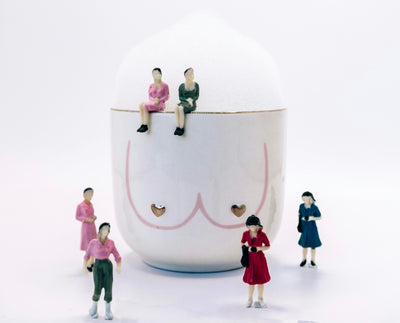The Top 6 Breastfeeding Myths Revealed
The Top 6 Breastfeeding Myths Revealed
by jordan berns
Sometimes it seems like there is just so much information out there to learn about breastfeeding. Often it can be hard to separate fact from fiction. To cut through the noise, here are seven of the most common myths about breastfeeding and the facts that should replace them!

1. Myth: You can’t become pregnant while breastfeeding.
Fact: Some women rely on lactational amenorrhea (LAM) as a form of birth control that when done perfectly, has a 2% failure rate. Using LAM, women can momentarily cease having periods by continuing to breastfeed. However, this form of birth control is very susceptible to error. With LAM, you can avoid pregnancy before six months postpartum if you breastfeed every two to three hours, including at night. Pumping or hand expressing milk decreases the chances of LAM working successfully. In this system, mothers nurse on demand and their babies cannot use pacifiers to soothe, only breastfeeding. Other options for birth control while breastfeeding can include condoms with spermicide, progesterone only mini-pill low dose combination birth control pills. Recent data supports that low dose birth control pills do not affect milk supply.

2. Myth: Breastfeeding ruins the appearance of your breasts and decreases nipple sensitivity
Fact: It is very natural for breasts to change shape while pregnant or breastfeeding. All breasts will naturally "go south" with age regardless of breastfeeding. Breasts become larger a couple of days immediately after giving birth due to temporary engorgement. Additionally, the idea that breastfeeding decreases nipple sensitivity is just another myth.

3. Myth: Breastfeeding women should only eat bland foods.
Fact: The most important thing about a mother’s diet is that it’s healthy! By the time your meal’s nutrition reaches your breast milk, it will largely be broken down and your baby won’t be affected by spicy flavors or other tastes. However, some foods, like diary and shellfish, are more potent than other foods in breast milk, which can irritate babies. If you suspect your diet is making your baby fussy, track what and when you eat so that you can determine your baby’s reaction to certain foods.
The misconceptions that follow conception!

4. Myth: Having breast implants or reductions makes it impossible to breastfeed.
Fact: While this can be true some of the time, it isn’t true in every case. Modern breast implants are usually inserted under breast tissue, under muscle, or under the armpit, which don’t hinder the flow of breast milk. If the nipple was removed and reattached during surgery, there might be a problem with oxytocin production, which can hamper milk letdown. It’s best to talk out these concerns with your doctor or lactation consultant.

5. Myth: Avoid taking medications while breastfeeding.
Fact: There are still plenty of medications you can take while breastfeeding. For example, as long as you follow your doctor’s instructions, over-the-counter pain relievers like Advil, Tylenol, and Motrin are safe to use. If you are feeling depressed or anxious, talk with your doctor as soon as possible. Depression, postpartum depression, and anxiety disorders are serious issues that require a clinician’s care. Some anti-depressants like Prozac and Zoloft are generally seen as the safest anti-depressants to take while pregnant. If you have talked to your doctor and took an approved anti-depressant while pregnant, you should be able to continue taking the same medication at the same dose while breastfeeding.
If you need to take a short-term medication that could harm your breastfeeding baby, take the medication as instructed while switching over to pumping and then immediately disposing of your breast milk until the medication has run its course and leaves your body. Then you should be able to return to breastfeeding.
Gone on long enough: the white lies no one should believe

6. Myth: The size and shape of your breasts affects how well you can breastfeed.
Fact: Small breasts are just as capable of producing milk as large breasts. The condition of the mammary gland tissue is what decides how much milk will be produced, not breast size. In pregnancy, the hormone estrogen promotes the formation of mammary gland tissue and helps the breasts grow larger. Progesterone, another hormone, creates the duct system that allows the milk to flow.
If you have inverted or flat nipples, don’t worry! Sometimes, inverted or flat nipples will adjust and change shape during pregnancy. Lactation consultants can help advise you on what latch position will work best for your body type.
During your pregnancy and breastfeeding, you may receive a lot of conflicting information in a way that is stressful and confusing. Having a doctor and lactation consult, like the ones through Lactation Lab’s telehealth services, help identify breastfeeding myths from breastfeeding reality will alleviate your worries and let you enjoy the process of breastfeeding.






